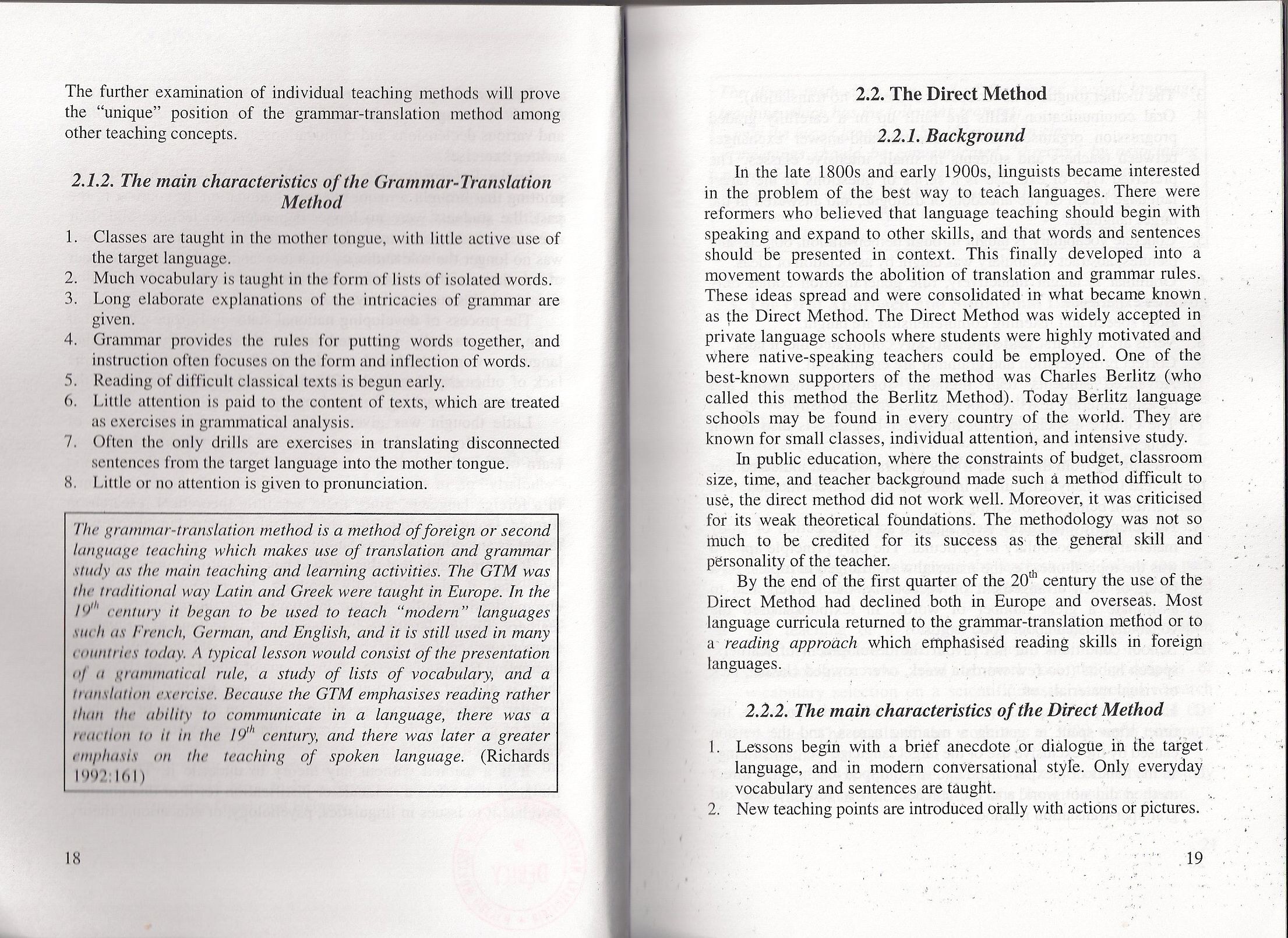skanowanie0009 (70)

The further exaimnation of individual teaching methods will prove the “uniąue” position of the grammar-translation method among other teaching concepts.
2.1.2. Themain characteristics of the Grammar-Translation Method
Classes are taught in the mother tongue, with little active use of the target language.
2. Much vocabulary is taught in the form of lists of isolated words.
3. Long elaborate explanations of the intricacies of grammar are given.
4. Grammar provides the rules for putting words together, and instruction often focuses on the form and inflection of words.
5. Reading of difficult classical texts is begun early.
6. Little attention is paid to the content of texts, which are treated as exercises in grammatical analysis.
7. Often the only drills are exercises in translating disconnected sentences from the target language into the mother tongue.
8. Little or no attention is given to pronunciation.
The grammar-translation method is a method offoreign or second language teaching which makes use of translation and grammar study as the main teaching and leaming activities. The GTM was the traditional way Latin and Greek were taught in Europę. In the /y century it began to be used to teach “modem" languages SUCh as French, German, and English, and it is still used in many eountries today. A typical lesson would consist ofthe presentation of o grammatical rule, a study of lists of vocabulary, and a translation exerclse. Because the GTM emphasises reading rather than the abillty to communicate in a language, there was a retu Ilon to it in the I9'h century, and there was later a greater mphasis on the teaching of spoken language. (Richards 1992:161)
2.2. The Direct Method
2.2.1. Background
In the late 1800s and early 1900s, linguists became interested in the problem of the best way to teach languages. There were reformers who believed that language teaching should begin with speaking and expand to other skills, and that words and sentences should be presented in context. This finally developed into a movement towards the abolition of translation and grammar rules. These ideas spread and were Consolidated in what became known. as the Direct Method. The Direct Method was widely accepted in private language schools where students were highly motivated and where native-speaking teachers could be employed. One of the best-known supporters of the method was Charles Berlitz (who called this method the Berlitz Method). Today Berlitz language schools may be found in every country of the World. They are known for smali classes, individual attention, and intensive study.
In public education, where the constraints of budget, classroom size, time, and teacher backgfound madę such a method difficult to use, the direct method did not work well. Moreover, it was criticised for its weak theóretical fóundationś. The methodology was not so ttitich to be credited for its success as the gehefal skill and pSrsonality of the teacher.
By the end of the first ąuarter of the 20“ century the use of the Direct Method had declined both in Europę and overseaś. Most language curricula retumed to the grammar-translation method or to a- reading approach which effiphasised reading skills in foreigń languages.
2.2.2. The maili characteristics of the Difect Method
1. Lessons begiń with a brief ąnecdote'or dialogtle ih the tafget, . language, and in modem conversational styfe. Only everyday
vocabulary and sentences are taught.
2. New teaching points are introdućed ofally with actións of pictures.
19
Wyszukiwarka
Podobne podstrony:
skanowanie0014 (47) • The communicative teaching is marked by an atmosphere of using and working wit
skanowanie0014 (47) • The communicative teaching is marked by an atmosphere of using and working wit
skanowanie0011 (59) 2.3.3 The main characteristics ofthe OralApproach 1. Language
skanowanie0042 (10) the preparation of lesson plans can be very helpful. Especially, if this knowled
skanowanie0041 (10) • The behaviour expected of the leamer on completion of unit o
76492 skanowanie0042 Plnk K., The Triumviri Monę tales and the Structure of the Coinage of the Roman
więcej podobnych podstron